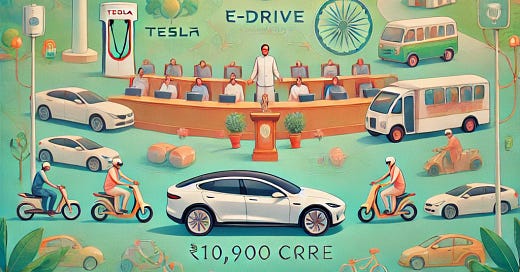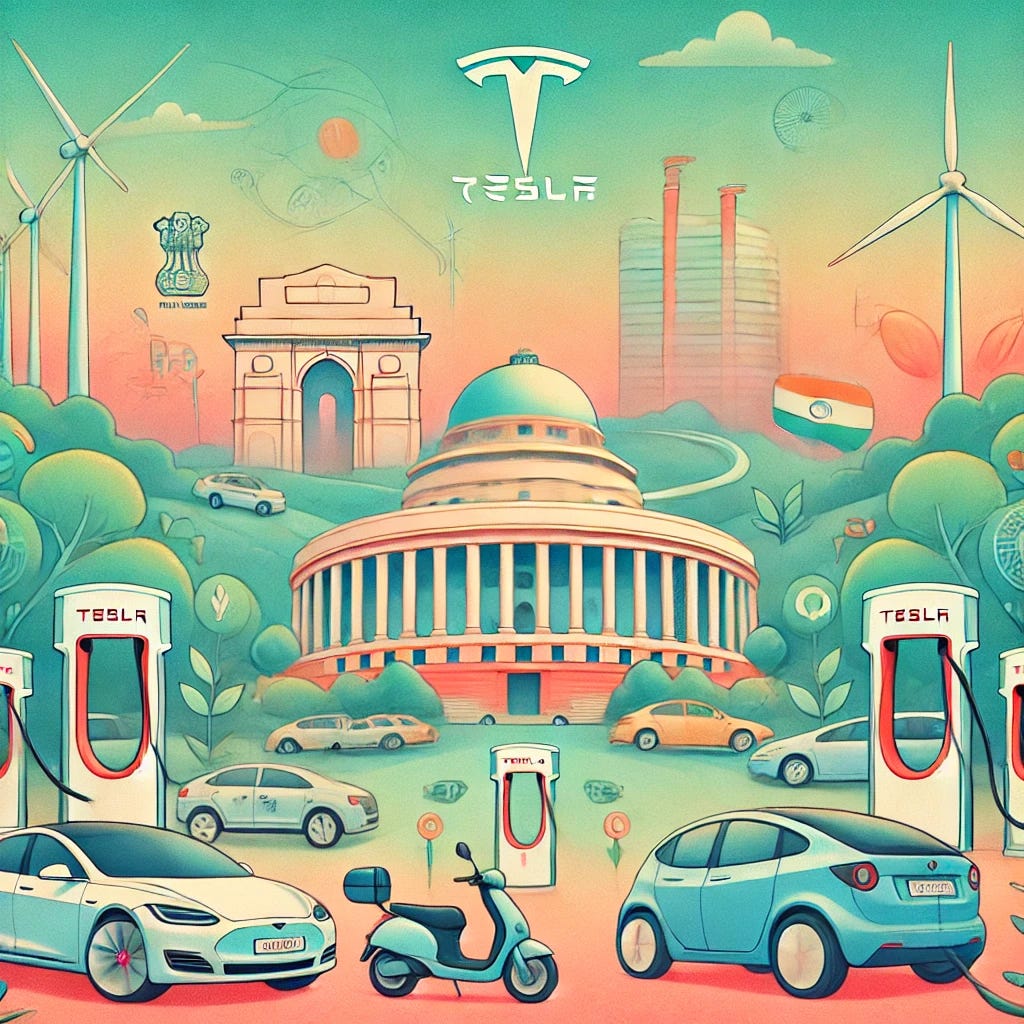Union Cabinet Approves ₹10,900 crore PM E-DRIVE Scheme
Tesla Cars, driverless or otherwise, however still remain a distant dream in India.
PM E-DRIVE Scheme: A Bold Push Towards Electric Mobility
In a groundbreaking move, the Union Cabinet, chaired by Prime Minister Narendra Modi, today approved the PM Electric Drive Revolution in Innovative Vehicle Enhancement (PM E-DRIVE) Scheme with an outlay of Rs. 10,900 crore over the next two years. This ambitious scheme aims to accelerate the adoption of electric vehicles (EVs) in India by providing various incentives, upgrading infrastructure, and integrating EVs into critical sectors like healthcare. Notably, the scheme also introduces innovative solutions such as e-vouchers and focuses on modernising India's EV manufacturing ecosystem.
E-Vouchers: Simplifying the EV Purchase Process
One of the key highlights of the PM E-DRIVE Scheme is the introduction of e-vouchers, designed to make the EV buying process smoother and more efficient. Under this scheme, buyers of EVs will receive Aadhaar-authenticated e-vouchers at the time of purchase, which will enable them to avail subsidies and other demand incentives. The system, which digitises and automates the incentive process, reduces paperwork and enhances transparency, allowing both buyers and manufacturers to access benefits more seamlessly.
Promoting Greener Healthcare: E-Ambulances
In a first for India, the PM E-DRIVE Scheme allocates Rs. 500 crore for the deployment of electric ambulances (e-ambulances). This initiative is a significant step towards integrating electric mobility into the healthcare system, particularly in urban centres grappling with pollution. E-ambulances, which will adhere to new performance and safety standards set in consultation with health and transport ministries, offer a sustainable and eco-friendly solution for patient transport. This is a visionary step towards making healthcare greener while maintaining efficiency and safety.
Incentivising E-Trucks: A Move Towards Cleaner Logistics
Trucks remain a major contributor to air pollution in India, especially in urban areas. To address this, the PM E-DRIVE Scheme includes Rs. 500 crore to incentivise the purchase of electric trucks (e-trucks), provided the buyer has scrapped an old, polluting truck through authorised scrapping centres. This initiative aligns with the government’s overall vehicle scrappage policy and encourages logistics companies to adopt cleaner technologies, significantly reducing emissions in the transportation sector.
Strengthening EV Infrastructure and Public Mobility
One of the most crucial components of the PM E-DRIVE Scheme is its focus on strengthening EV infrastructure. Rs. 4,391 crore has been allocated for the procurement of 14,028 electric buses (e-buses), aimed at transforming public transport in major cities like Delhi, Mumbai, Kolkata, and Bengaluru. The buses will be deployed under the centralised procurement model to ensure cost efficiency and standardisation. Additionally, Rs. 780 crore will be spent on upgrading vehicle testing agencies, ensuring that India’s EV industry adheres to global safety and performance standards.
Moreover, Rs. 2,000 crore has been allocated to install fast charging stations in cities with high EV penetration and along key highways. This will go a long way in addressing range anxiety, one of the most significant barriers to widespread EV adoption.
Tesla and Driverless Cars: Challenges in India
Despite India’s strong push towards electric mobility, Tesla’s entry into the Indian market remains complex. While Union Minister for Road Transport and Highways Nitin Gadkari has encouraged Tesla to manufacture cars in India, he has made it clear that Tesla cannot sell vehicles manufactured in China to Indian consumers. This poses a challenge to Tesla’s current business model, which relies heavily on its manufacturing hub in China.
Additionally, driverless cars, a hallmark of Tesla’s future vision, face regulatory roadblocks in India. Gadkari has explicitly stated that driverless cars will not be allowed in India, due to concerns about the impact on employment in the transport sector. With millions of drivers depending on their jobs for livelihood, the introduction of autonomous vehicles could lead to significant job losses, creating socio-economic challenges that the government is cautious to avoid.
Ola Electric IPO: A Boost to Domestic EV Players
The PM E-DRIVE Scheme has been a significant catalyst for Ola Electric, one of India's leading domestic EV manufacturers, particularly following its successful IPO. The scheme’s emphasis on incentivising e-2Ws, e-3Ws, and public transport vehicles has fostered a highly favourable business environment for domestic manufacturers like Ola Electric, boosting the company's strong market performance.
Ola Electric’s IPO saw overwhelming investor interest, being oversubscribed 4.27 times. Since its debut, the company’s shares have nearly doubled, rising from the initial issue price of ₹76 to ₹137.7 in the latest trading session, reflecting a substantial 81.2% increase.
The government’s aggressive push for electric mobility, exemplified by the PM E-DRIVE Scheme, has provided further momentum to Ola Electric’s growth trajectory. The focus on expanding charging infrastructure and modernising testing facilities is expected to give domestic players like Ola a competitive edge, enabling them to scale production and meet the surging demand for EVs.
Ola Electric’s strong post-IPO performance underscores investor confidence in both the company’s potential and the government’s commitment to supporting homegrown EV manufacturers. This aligns seamlessly with Ola’s ambitious expansion plans, including its recent foray into the electric motorcycle market with the launch of the Roadster Series.
Challenges to the EV Revolution in India
While the PM E-DRIVE Scheme is a significant step forward, the transition to electric mobility in India faces several challenges. The high upfront cost of EVs remains a critical barrier for many buyers, especially in the two-wheeler and commercial vehicle segments. Despite the availability of subsidies, EVs are still costlier than their internal combustion engine counterparts, making them less attractive to middle-income consumers.
Another major challenge is the lack of sufficient charging infrastructure outside major urban centres. Although the scheme promotes installing fast chargers, rural and semi-urban regions still lack the necessary charging infrastructure, limiting the penetration of EVs beyond metropolitan areas.
Furthermore, EV battery production and disposal are becoming pressing environmental issues. As the demand for EVs grows, so does the need for eco-friendly sourcing and recycling of lithium-ion batteries. If not addressed, this could undermine the environmental benefits of electric vehicles.
Looking Forward: Cautious Optimism for India’s Electric Future
The PM E-DRIVE Scheme represents a bold leap towards an electric future for India, integrating innovation, infrastructure, and incentives to drive adoption. The scheme’s wide-ranging initiatives, from e-ambulances to incentives for scrapping old vehicles, show a comprehensive approach to tackling pollution and promoting green mobility.
However, challenges like the high cost of EVs, gaps in infrastructure, and environmental concerns related to battery production need continued attention. Additionally, with the absence of Tesla's manufacturing and the regulatory restrictions on driverless cars, India’s EV landscape remains complex.
Nevertheless, there is room for cautious optimism. As domestic players like Ola Electric rise to the occasion and government support continues, India is well on its way to becoming a global hub for electric mobility. The next few years will be crucial in determining the scale and speed of this transition, but the direction is clear: India's electric revolution is gaining momentum.





